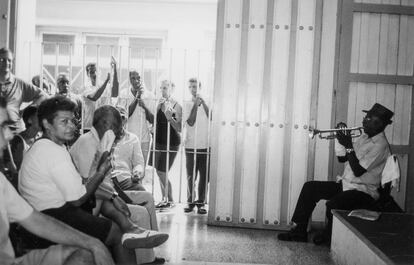The science of Latino music in motion
Some say itˇŻs distracting, but others like to play it while they work. Latino music ¨C loud and full of rhythm and high frequencies ¨C has intrinsic qualities that make it unique, enjoyable and vital for its fans. What are these qualities?

Since the dawn of civilization, people have felt the need to arrange sounds such as rhythm, melody, tempo and harmony into what we think of as music. It doesnˇŻt just stimulate the senses ¨C music is a reflection of who we are, where we come from, and the nature of our desires and impulses.
If we want to get to know an individual, a people, or even an entire country, we just need to listen to the sounds they make. A peopleˇŻs musical heritage and conversations often provide timely and valuable information that helps us understand who they are.
Socio-historical analysis offers a useful approach, but the scientific analysis of certain biological mechanisms can also help explain our attachment to music and how it can benefit us. In Musicophilia: Tales of Music and the Brain, the famous British neurologist and writer Oliver Sacks (1933-2015) explains the pathology of how music affects human beings at a neurological and therapeutic level by connecting our immediate reality and senses with memories.
According to Sacks, music can induce abnormal activity in the temporal lobe of an epileptic and potentially cause seizures. There are also differences in the way we perceive music. Extreme examples include congenital amusia (tone deafness) and synesthesia ¨C when you experience one of your senses through another, such as when a person hears music but sees shapes.
Musicophilia describes the authorˇŻs use of music therapy to treat patients with severe amnesia and ParkinsonˇŻs disease. Music, says Sacks, is closely linked to emotion, even in people with musical anhedonia (the inability to derive pleasure from music) or with Williams syndrome (being extraordinarily responsive to music).

This scientific approach could explain an affinity for the repetition, quadrature and high energy of a march, or the mesmerizing and ritualistic compositions of techno and electronic music. Our favorite types of music decipher who we are and where we come from.
This is vitally important for the Latin American musical identity, which has been characterized as colorful, energetic, happy and warm, but also romantic, sometimes contradictory and dramatic. Our music has certain common qualities that engage us and express much of our identity, whether itˇŻs a bolero, cumbia, salsa, ranchera, mariachi, merengue, tango, or reggaeton song.
The Latino sounds heard in California, Texas, Illinois, New York and all over the US, evoke our now-distant Spanish and Portuguese heritage. But there is much more, like the enormous influence of Afro-Caribbean rhythms, Spanish d¨¦cimas (a style of poetry that is octosyllabic and has 10 lines to the stanza), syncopation that stresses weak rhythmic beats instead of strong ones, and an affinity for call and response musical phrasing. Although it has evolved over the years, this musical style stimulates the mind and body, as Oliver Sacks would say, infusing it with energy and the need to dance and move instinctively to the rhythm.
While Latin American music may be directly related to the stimulation of our senses, its emotional impacts are somewhat more complex. Individual factors such as neurological conditions, memories, and experiential associations of certain songs with a person or image ¨C all of these influences can transport the mind to a wide variety of musical genres or styles.

So the next time your aunt gets teary-eyed listening to a seemingly random merengue, or your best friend stops what heˇŻs doing to sing the song playing on the radio, now you know why it happens and what it means for a Latino.
Sobre la firma
